In my wildest dreams, I never thought I’d be writing about two different cushion-shaped chronographs made especially for women. This is a particularly enjoyable exercise for me as the two chronographs I examine here are by two of the most traditional watch manufactures at work today: Vacheron Constantin and Patek Philippe.
The cushion shape is an unusual one, rarely seen in modern watchmaking. Like the tonneau shape, it arose from the watchmaker’s need in the early days of the wristwatch to differentiate from the pocket watch.
As the first wristwatch cases were more or less reconfigured pocket watches, manufacturers were keen on showing their potential clienteles that they were innovating. Thus, they invented new case shapes.
I have always had a particular soft spot for the cushion shape, finding it very pleasing with its rounded corners and soft, flowing lines.
So in 2009, when Patek Philippe honored both women and the cushion-shaped case with a wristwatch called Ladies First, I was indeed very pleased.
Patek Philippe Caliber 29-535
I was even more pleased to discover that its movement was a groundbreaking one for the venerable Genevan manufacture: it was the first hand-wound chronograph fully conceived, developed, and manufactured in-house.
You may wonder a bit about the latter statement, for Caliber 27-70 was long regarded as an exceptional, classic hand-wound chronograph movement, one that also provided the base for Patek Philippe’s perpetual calendar.
Introduced in 1986, Caliber 27-70 was based on the 2310 ébauche delivered by Nouvelle Lémania to Patek Philippe’s specifications – specifications strict and elegant enough to fulfill criteria for the Seal of Geneva after Patek Philippe’s own watchmakers had reworked it. Caliber 27-70 was used in such classic timepieces as the Patek Philippe Reference 5070 chronograph.
Ladies First’s caliber was brand-new and specifically designed to power the next generation of Patek Philippe chronographs and perpetual calendars. Named 29-535 in honor of its dimensions, the Ladies First movement shares a number of elements with its predecessor – however, dimensions are not one of them. At 29 mm in diameter, Caliber 29-535 is two millimeters larger than Caliber 27-70, while its height is somewhat lower.
Ladies First is controlled by a typical, modern set of two start/stop and reset buttons on the right side of the case. The way the chronograph runs is, however, quite unique. Caliber 29-535’s 269 components were conceived to have the second counter also act as the running second hand, virtually unheard-of in such a movement.
Caliber 29-535 boasts a guaranteed 65 hours of power reserve with the chronograph running and more than 70 hours if the timer is not activated.
Laurent Junod, in charge of Patek Philippe’s U.S. service center, explained that one of the six patents granted for the movement – all of which are aimed at improved reliability – is for the asymmetric tooth profile of the chronograph’s clutch mechanism. It is this detail that makes both this long power reserve possible and also ensures much smoother chronograph second hand operation, avoiding much of the jumping often seen under a technician’s high-speed camera.
While Caliber 27-70, which oscillated at 2.5 Hz (18,000 vph) was outfitted with a vertical clutch – a clutch control system many consider top dog among chronograph mechanisms – the new 3 Hz (28,800 vph) movement is outfitted with a more traditional horizontal clutch. “We wanted this to be a fully traditional movement,” Junod explained of the caliber christened with Patek Philippe’s own seal (which fulfills all the criteria of the Seal of Geneva as well).
One other important difference between the new and old movements is found in the hacking seconds of Caliber 29-535, which means that when the crown is pulled out the balance wheel stops, allowing the watch to be set precisely to the second by its owner.
Vacheron Constantin Caliber 1142
The small Harmony chronograph was introduced as part of the full set of seven cushion-shaped timepieces this equally venerable Genevan manufacture brought out in honor of its 260th anniversary at the 2015 SIHH. (For more on this, please read Vacheron Constantin’s Harmony Collection: Poetry In Chronographic Motion.)
Here, too, I felt great appreciation at this brand thinking to include something that would appeal to female connoisseurs. While the rest of the Harmony collection contains movements specifically designed and manufactured for these watches, the Harmony Chronograph Small Model contains a reworked rendition of the Nouvelle Lémania Caliber 2310 that Vacheron Constantin has named Caliber 1142 (as it is also a variation of the already-existent Caliber 1141, also based on the same Lémania caliber).
Caliber 1141 has been used as a base movement in various Vacheron Constantin models, including the Malte, Traditionelle (such as the Reference 47292 chronograph perpetual calendar), and Les Historiques chronograph (Reference 49002) lines for more than 20 years.
As with Patek Philippe’s original Caliber 27-70, the ébauche delivered from Breguet (now the owner of Nouvelle Lémania; the current Breguet factory is the old Lémania factory) is so well made that after Vacheron Constantin has finished it attains the Seal of Geneva – one of Vacheron Constantin’s big draws being its exceptional finishing. The movement has also been reworked so as to feature a higher frequency of 3 Hz (21,000 vph) versus the 2.5 Hz (18,000 vph) of the previous Caliber 1141.
The biggest difference, though, is that the swan-neck fine adjustment has been traded out for micro screw regulation on the balance wheel. A Maltese cross has been added to the column wheel screw in keeping with Vacheron Constantin’s tradition of fine finishing and using its traditional emblem within the movement where possible.
While there may be extreme purists who wrinkle their noses at this continued practice of using the Lémania ébauches, we should keep in mind two important facts: one, this base movement is incredibly reliable, which is the main reason for its continued use by Vacheron Constantin, the oldest continually operating manufacture in Switzerland. And, two, as Lémania now belongs to the Swatch Group, which is seriously curbing movements sold to third parties, the movement has become quite rare.
Today, one only finds this Lémania chronograph movement ticking away within the watches of prestigious brands.
The calibers of the limited edition Harmony timepieces introduced in this anniversary year contain a special engraving that the subsequent unlimited collection pieces will not have: a scrolling motif inspired by the engraving found on the balance cock of the oldest pocket watch in Vacheron Constantin’s possession, from 1755 and signed by Jean-Marc Constantin.
Known as fleurisanne-style engraving, this decorative addition appears on the rotor, the chronograph bridge, and the balance cock. A commemorative inscription is also found on the case back of the anniversary timepieces.
Design
Ladies First very much emulates Patek Philippe’s 1930s style, which then-head of the Patek Philippe Museum in Geneva Arnaud Tellier has termed the golden age of chronographs. In fact, he explained at the 2009 launch that the 39 mm, 18-karat pink gold cushion shape of the case and the layout of the dial could be found in various Patek Philippe monopusher chronographs as early as 1929.
While I may have been less enthusiastic about the 136 diamonds embellishing this timepiece in 2009, six years down the road I find them to be a grateful and worthy design element likely to make the chronograph appeal more to (other) women. The Vacheron Constantin Harmony Chronograph Small Model includes 84 diamonds, set in much the same way with two rows in the corners where the cushion-shaped case extends further away from the round dial.
The Vacheron Constantin Harmony Chronograph Small Model appeals equally well to me in terms of design. Its design cues – overseen by the amazing Christian Selmoni, who, with his detailed and creative eye, is an institution at Vacheron Constantin – were inspired by the brand’s first wrist chronograph from 1928: Reference 3306, a monopusher chronograph..
This style was perfectly transposed so as to become a modern timepiece with a classic elegance that does not in the least look old-fashioned.
Both the Patek Philippe Ladies First and the Vacheron Constantin Harmony Small Model include two chronograph pushers as is the norm today.
The real differences in these two designs are to be found in the lugs, the rounding of the case corners, and – of course – the two house-style dial designs. All three of these elements are subject purely to personal taste, and the combination of them will appeal more to some and less to others.
The Patek Philippe case is softer, more rounded at the corners. It also includes an extra “bar” at the top and the bottom so that the attached lugs do not look like foreign bodies. The Vacheron Constantin case is quite a bit more angular, and its lugs and case are one piece following a “shape in shape” approach: the sapphire crystal is round, only covering the actual dial and not the corners.
On the Patek Philippe, the sapphire crystal is shaped like the case and covers the entire front of it. In fact, it has a bit of a bezel to accommodate the sapphire crystal, while the Vacheron Constantin case does not. This allows the latter to have a more open look, but also allows it to be two millimeters smaller in diameter.
That these two beautiful chronographs by Patek Philippe and Vacheron Constantin share a common case shape and in a way movement history should not really come as such a surprise. The world of watches is interwoven with all sorts of common historical tapestry. Which one a consumer chooses in the end is left entirely to personal preferences.
I, for one, like them both.
Quick Facts Patek Philippe Ladies First Reference 7071
Case: 39 mm, pink gold, yellow gold or white gold with 136 brilliant-cut diamonds
Movement: manually wound Caliber 29-535 with column wheel-controlled chronograph; Patek Philippe Seal
Functions: hours, minutes, seconds; chronograph
Limitation: limited production
Price: $91,500
Quick Facts Vacheron Constantin Harmony Chronograph Small Model
Case: 37 x 46.6 x 11.74 mm, pink gold with 84 round-cut diamonds (approx. 1.2 ct)
Movement: manually wound Caliber 1142, based on Nouvelle Lémania Caliber 2310 (licensed from Breguet) with column wheel-controlled chronograph; Seal of Geneva
Functions: hours, minutes, seconds; chronograph
Limitation: 260 pieces of the anniversary edition featuring special movement engraving; an unlimited version is expected as of 2016
Price: $65,000
Trackbacks & Pingbacks
-
[…] When you turn the watch over, you also realize that Caliber CH 29-535 PS with its six technical patents aimed at improving reliability is equally as beautiful. This caliber, by the way, was first introduced in the lovely Ladies First chronograph (see Two Exceptional Cushion-Case Chronographs For Women: Patek Philippe Ladies First And Vacheron Constan…). […]
Leave a Reply
Want to join the discussion?Feel free to contribute!





















































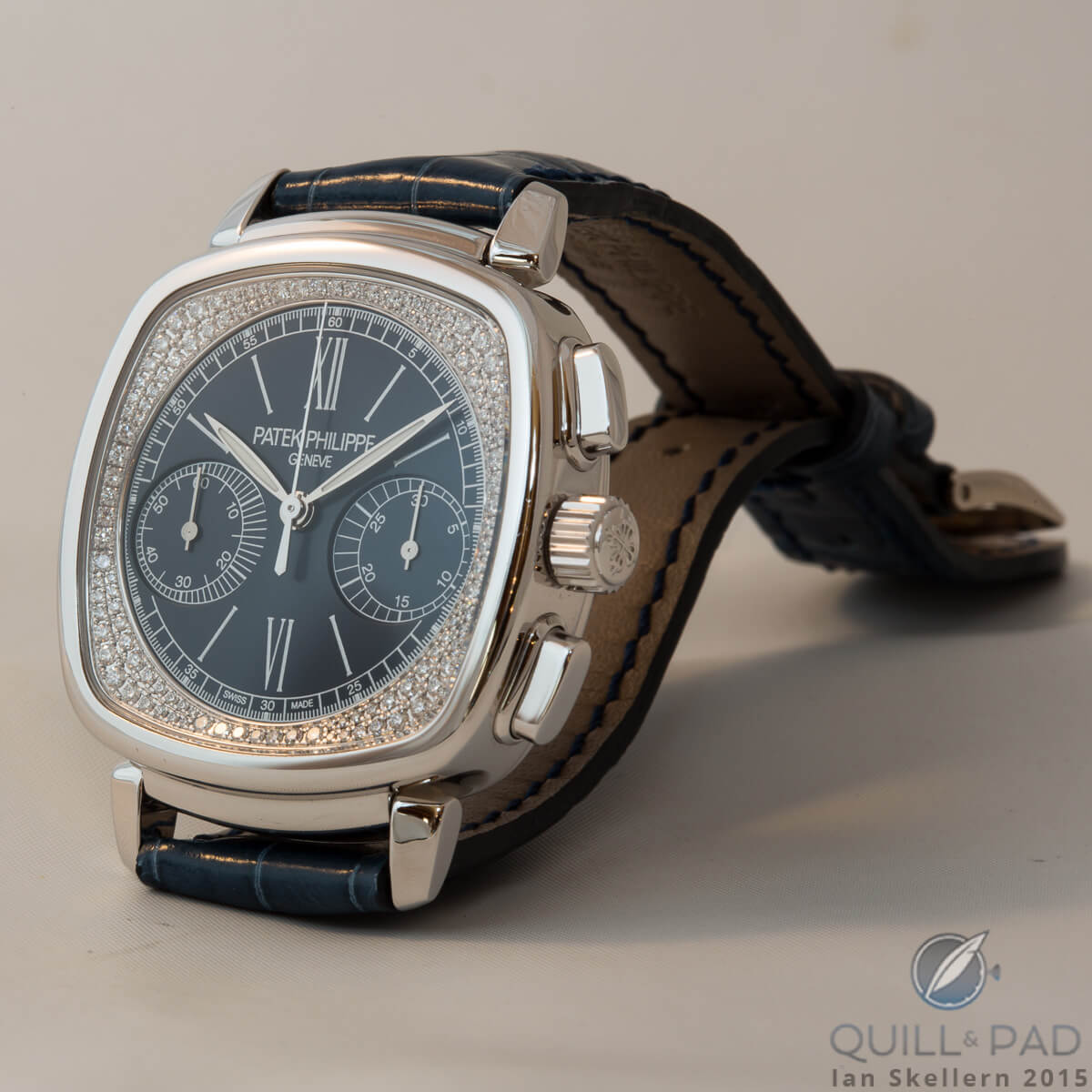
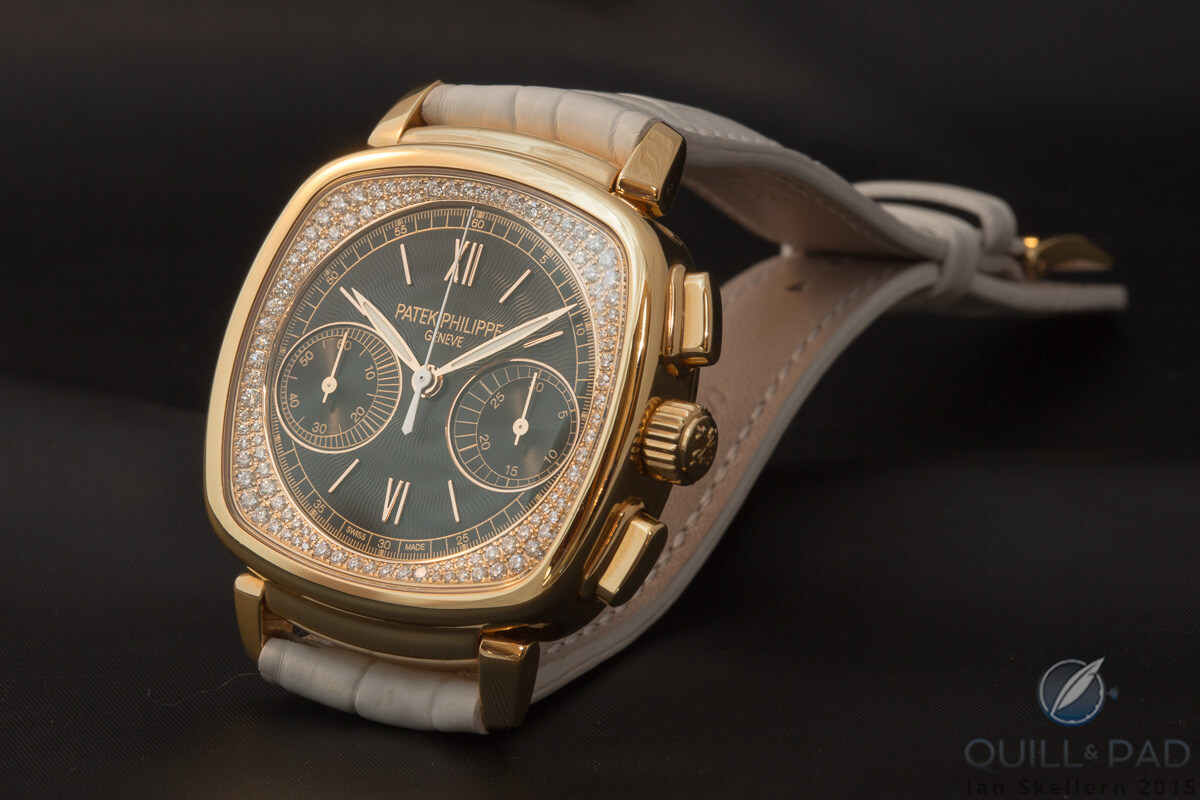
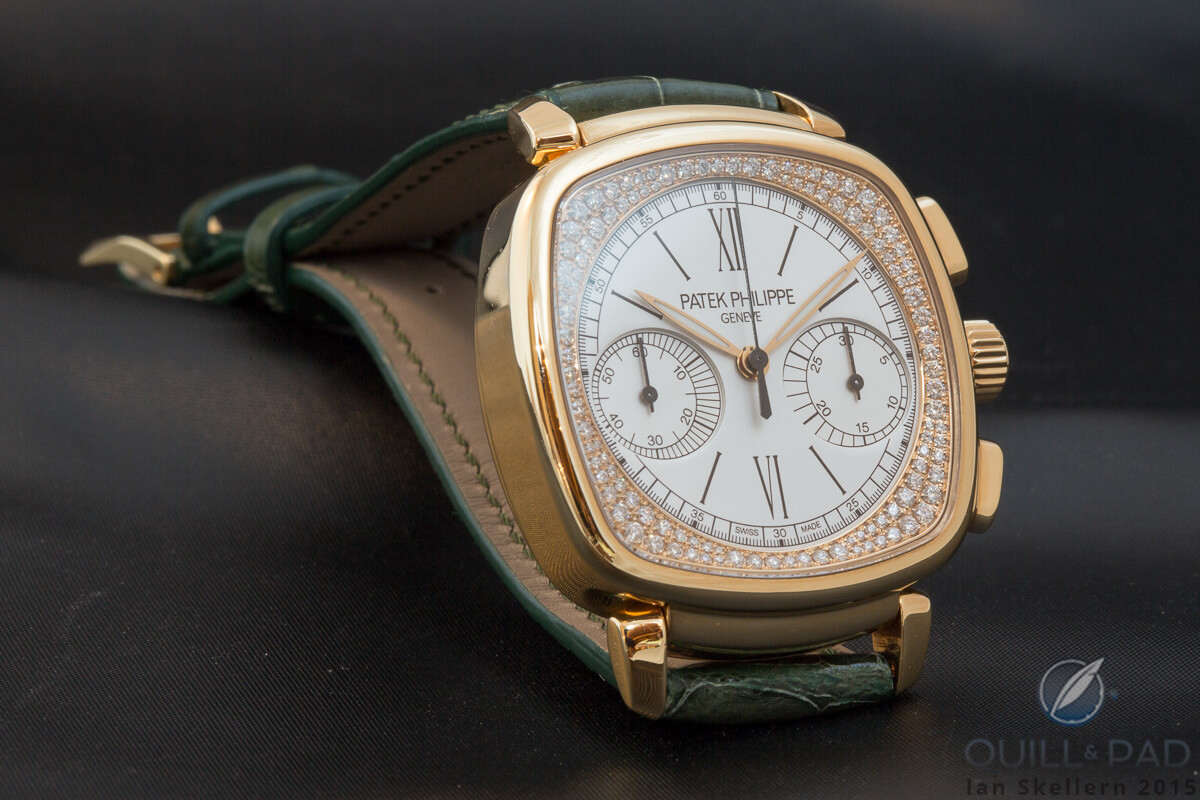
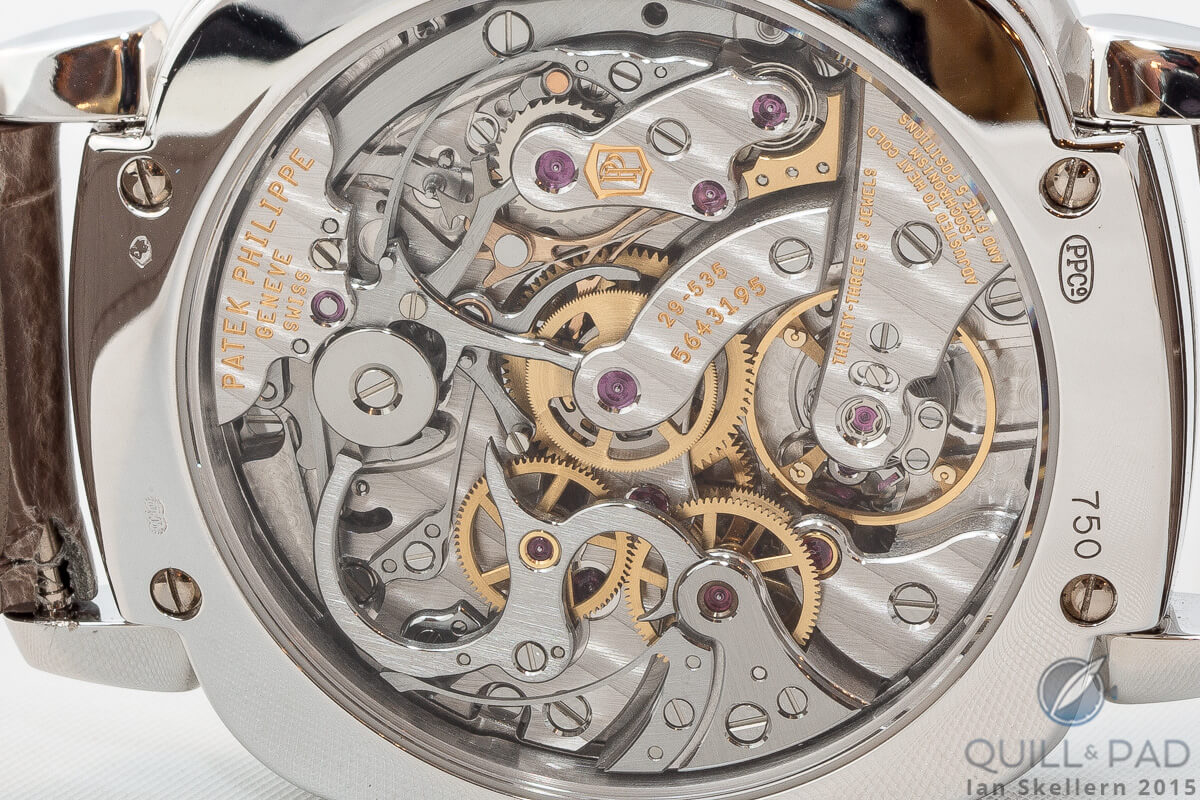
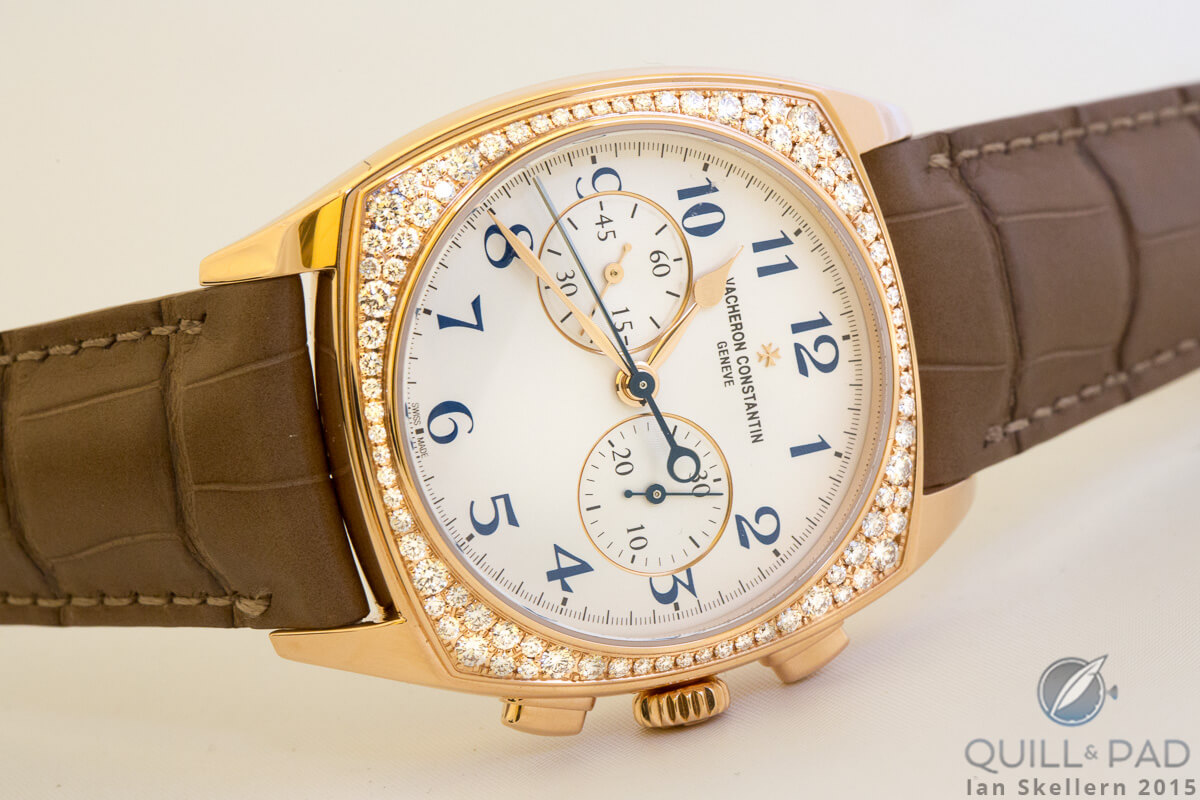
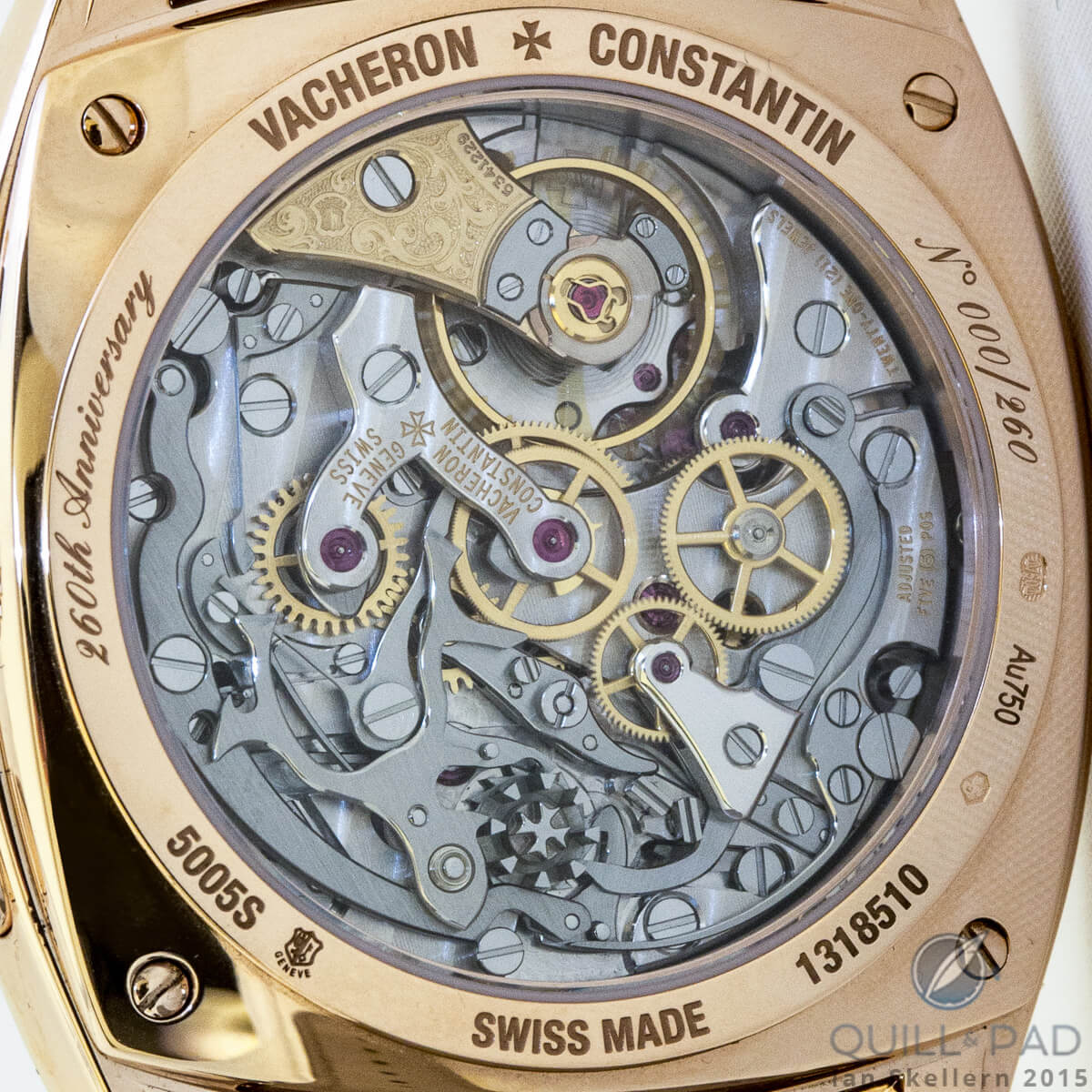
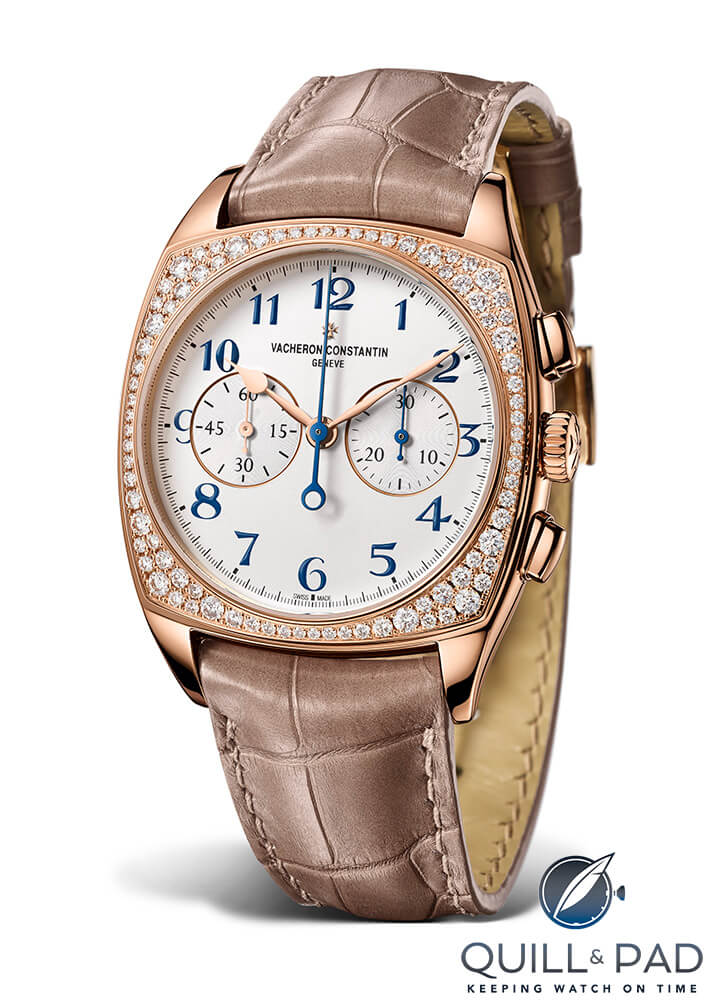
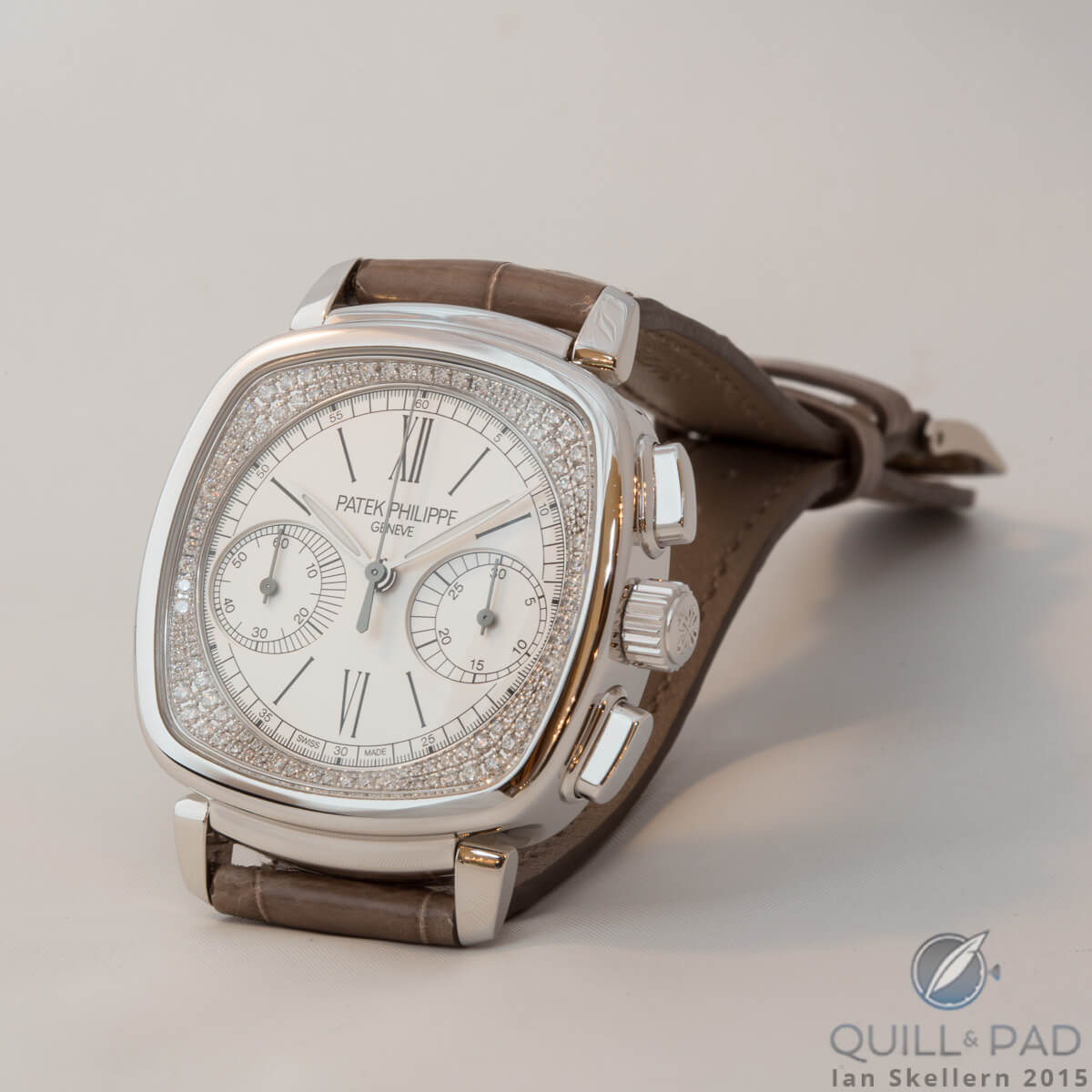
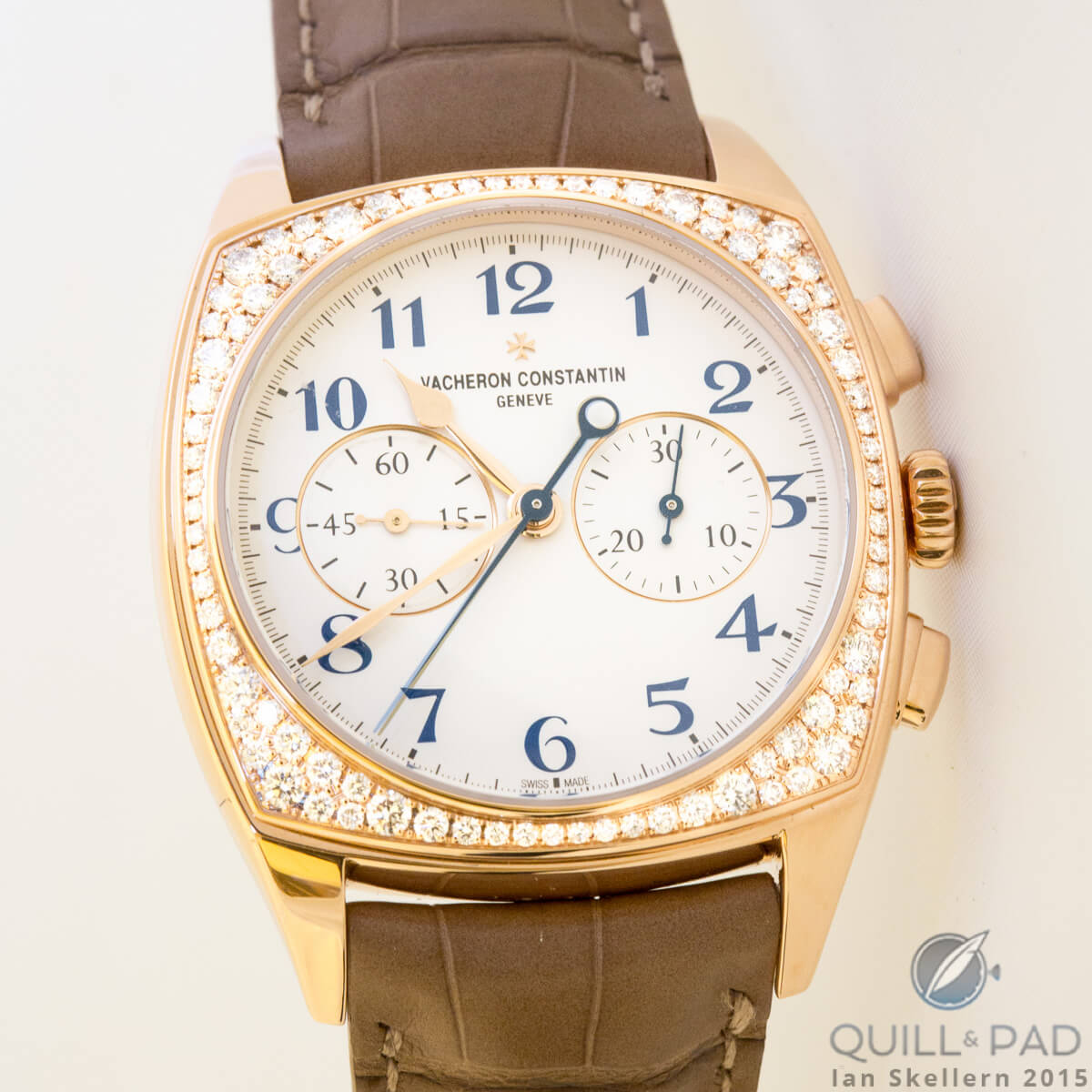
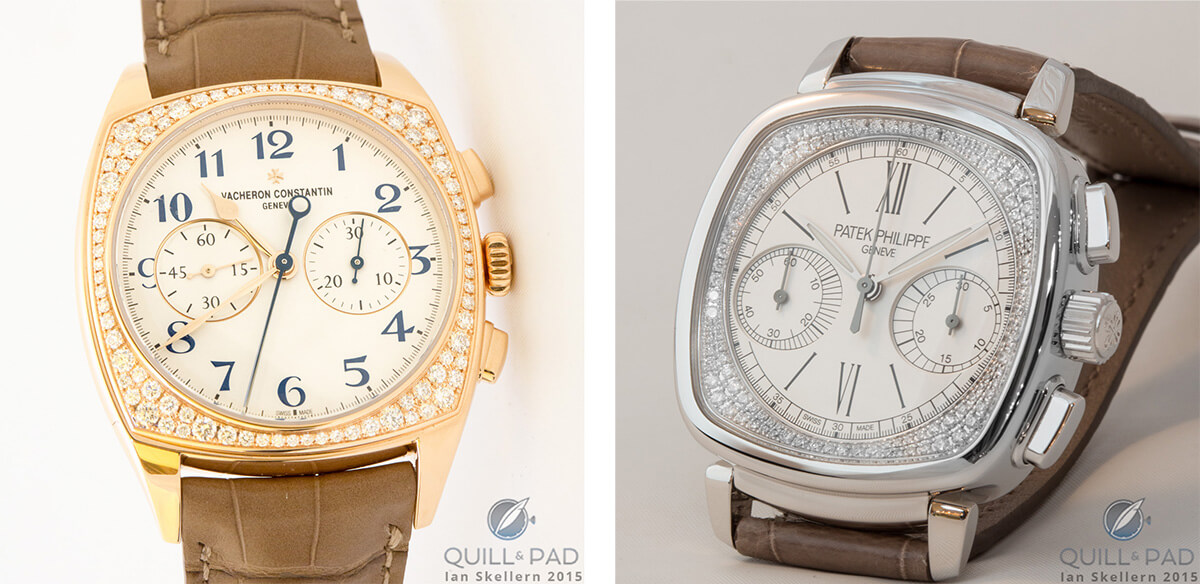
Sorry, but the Patek has a more beautiful exterior with the diamonds being inside the dial and the dial not being perfectly round. The Patek lugs are unique and beautiful. As far as the movements, they are both great, the Patek has a hacking mechanism. Price wise, the Patek is way up there but will likely hold its price better. Selmoni was definitely outflanked.
Au contraire, the VC Harmony trumps Patek’s Ladies First by all accounts.
The VC Harmony’s design has cleverly converged heritage with contemporary elegance. Patek’s version look like something that shat out of a 1960s museum. Utterly.confusing dial, subdials and.sundued diamonds. It is poorly designed and constructed piece and Patek knows that this was a turkey. The VC Harmony is a triumph and has won the hearts of watch purists, elite collectors and even the random peasant. Diamonds don’t need to be sheltered behind a glass and please Patek Phillipe, sort out the ugly dial markers and Art Deco inspired Roman numerals. You are not JLC.